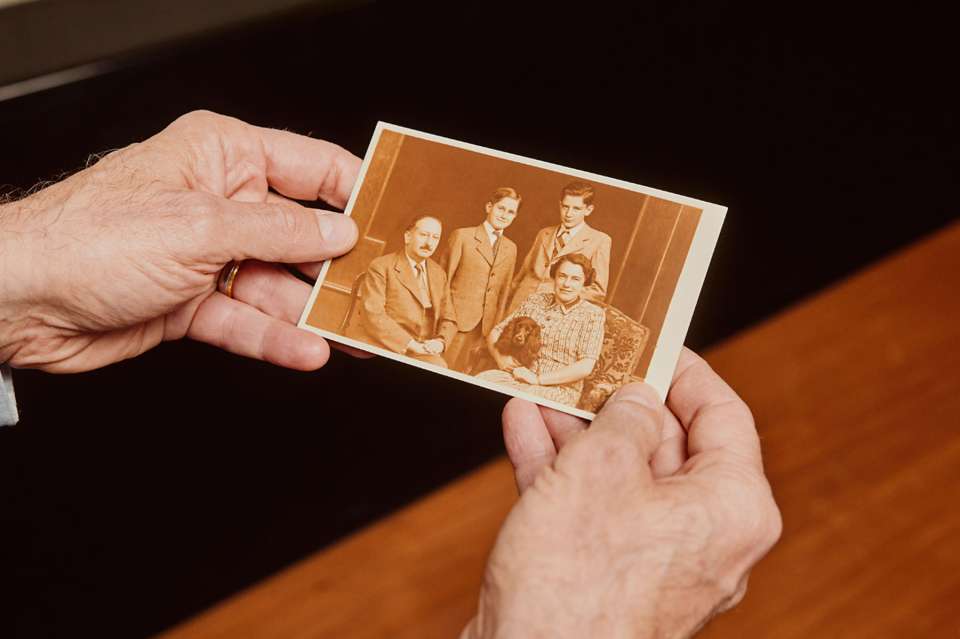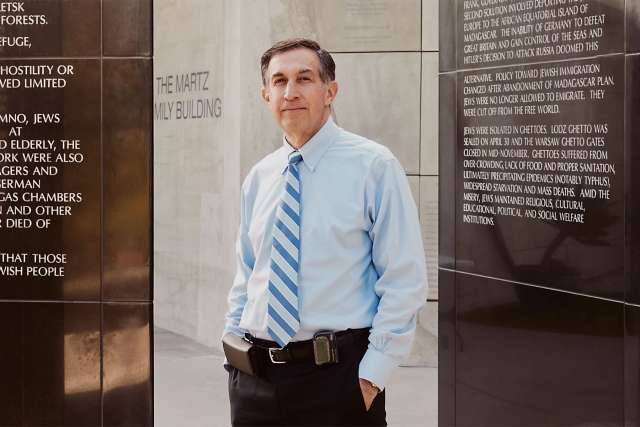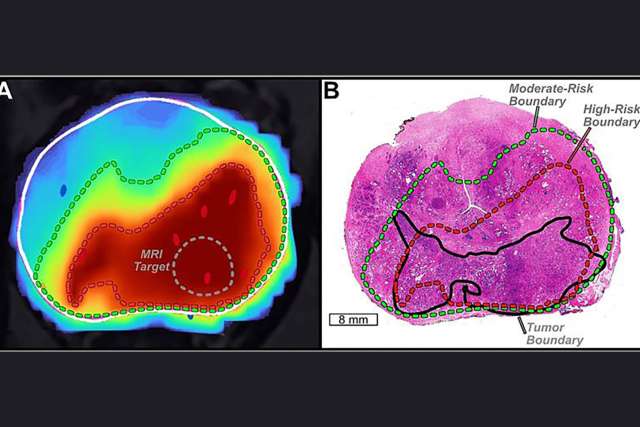By Jason Millman
GROWING UP, GARY J. SCHILLER, MD (RES ’87, FEL ’90), listened to the stories his father told of the terrible years as a teenager he spent in Poland’s Lodz Ghetto during World War II and then surviving the notorious Buchenwald concentration camp, among others.
“My father never hesitated to talk about what he went through in the Holocaust,” says Dr. Schiller, professor of medicine and director of the Bone Marrow/Stem Cell Transplant Program at the David Geffen School of Medicine at UCLA. “I’m sure that left some sort of imprint on me, there’s no doubt about it. Most children of survivors reflect on these things throughout their lives.”
Such reflections have led Dr. Schiller to seek opportunities to engage with the broader community of Holocaust survivors and their descendants. Twenty-three years ago, he took on the challenge of saving the oldest museum of remembrance in the United States, what then was known as the Los Angeles Museum of the Holocaust and is now Holocaust Museum LA. Prior to that, he was president of Second Generation, a group for descendants of Holocaust survivors.
Amid a troubling rise in anti-Semitism today, it is hard to imagine that not that long ago, Los Angeles almost lost its legacy institution dedicated to remembrance. Founded as the Martyrs Memorial in 1961 by Holocaust survivors in an English-asa- second-language class at a local high school, the museum, with a mission to commemorate those who died in the Holocaust and honor those who survived, struggled to find a permanent home and for years bounced around temporary locations and eked out a meager existence on a shoe-string budget.
When Dr. Schiller became chairman of the institution in 2000, it had lost a key source of funding, and its continued existence was anything but certain. If the museum had no home, what to do with all its artifacts that had been donated over the years by survivors? It was suggested, at one point, that they be placed in a display case at a local Jewish high school. “I thought that was cynical, and under no circumstances would we do that,” Dr. Schiller says.
Like a patient in desperate need of blood, an infusion of cash was urgently required if the museum was to survive. “Fundraising is something familiar to any physician in academic medicine, but it is much harder when it comes to raising money for Holocaust remembrance,” Dr. Schiller says.
Embarking down such a road was not, however, an easy choice for Dr. Schiller, who was leery of “commercializing” the Holocaust to raise money. “You know the old joke: ‘There’s no business like Shoah business,’” he told the Los Angeles Jewish Journal in 2001. “American Jewry has a problem with Holocaust remembrance. I am not the first or the last one to explain this.”
But fundraising is exactly what was necessary — though it was at times difficult to reckon with the fact that Los Angeles already had another wellfunded museum primarily focused on the Holocaust, the Museum of Tolerance. “But that museum is state-funded, and it has a different agenda,” Dr. Schiller says. “We had to make the connection for people: Why is this meaningful, why is this valuable, why is this important to you and your family?”
Ultimately, Dr. Schiller and the leadership of the museum were successful enough in their efforts to, in 2010, establish a permanent home in Los Angeles’ Pan Pacific Park. Since then, the museum has had more than 500,000 visitors, and it is planning an expansion that will nearly double its size as it aims to significantly grow its annual attendance.

Telling the story of the Holocaust is in Dr. Schiller’s blood. His father, Frank, a Czech Jew, was 15 in 1941 when he and his family were sent to the Lodz Ghetto, where both of his parents would die. After nearly three years, Frank was sent to a succession of forced-labor and concentration camps.
He survived — stories of what happened during those years are harrowing — and immediately after the war wrote a memoir about his experiences. He then set it aside for the next 45 years, when it was translated into English but never published. Such a contemporaneous account of the Holocaust was rare. “Those who survived, most were young, they wanted to move on with their lives,” Dr. Schiller says.
These days, Dr. Schiller is chairman emeritus, and he remains active in the museum community. Over the years, his work with the museum has been a family endeavor. His teenage son has become active in the museum, serving as a docent and creating an educational platform on Greek Jewry. Dr. Schiller’s father, who died in 2020 at the age of 94, previously helped with the museum’s books and served as “de facto treasurer for a long time,” Dr. Schiller says. Not only did Dr. Schiller’s father imbue him with a deep sense of connection to his past, but he also was instrumental in steering him toward a career in medicine. His father, Dr. Schiller says, believed it was important that his children pursue a career that not only would bring them esteem, but also, crucially, be easily transportable — “in case you need to get out quickly,” a vocational version of sewing jewelry into the lining of one’s garments.
When it was time for him to choose a direction in medicine, Dr. Schiller decided to focus on blood cancers, which he saw as a neglected area. “I wanted to do something that other people didn’t want to do,” he says. He has come to see para l lels between his efforts to educate people about the Holocaust and his work with cancer. Whether talking about the 6 million killed in the Holocaust or about cancer-survival rates, “both numbers are dispassionate data points that can be hard for people to comprehend,” Dr. Schiller says.
But, “as I’ve gotten older, I no longer view the material with dispassion. Dealing with cancer or teaching about the Holocaust — it is quite emotive. We are talking about life-threatening illness or a very challenging history. That touches on all the difficult emotional things that are involved in being human,” Dr. Schiller says. “These are things I didn’t appreciate as a young person. I do now.”
Jason Millman is a senior media relations officer for UCLA Health




